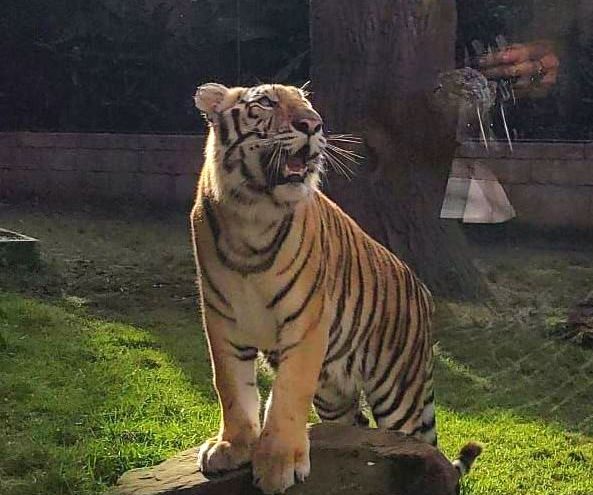tigers of the maharaja's temple
Catch a glimpse of our magnificent tigers! We are home to three incredible tigers. Our Bengal tiger, Apollo was a rescue and our two Sumatran tigers are part of the AZA's Species Survival Plan. More details below!
meet our tigers
our tiger Exhibit
Our immersive exhibit has multiple levels, retreats and enrichment experiences designed for our tigers.
OUTDOOR EXHIBIT
Watch our tigers through floor to ceiling glass, while they lounge and play outdoors.
- Waterfall with a chilled and heated pool
- Enrichment Tree
- Training Window
Kids can get up close with their favorite tiger in our
Kid Crawl space!
INDOOR EXHIBIT
Watch our tigers through floor to ceiling glass as they relax and take catnaps inside.
- Large pool for encouraged water play
- A temperature-regulated exhibit features soundproof glass, multiple levels for climbing, multiple skylights and windows to provide natural sunlight.
On your visit you might see our staff rotating enrichment activities with our tigers and bringing new activities or 'toys' to ensure they are always engaged or entertained.
Read all about Enrichment below!
TIGER TALKS
Ever wonder why there are tigers at the Downtown Aquarium? We’re more than just fish! Stop by for a Tiger Talk happening throughout the day to learn all about these incredible big cats from our Aquarium Educators. Find out how much a tiger sleeps, how to tell our tigers apart, what they eat, and why they’re here as part of our mission. Can’t catch a talk? Just ask an Educator nearby! They’re always happy to share wild tiger facts and stories!
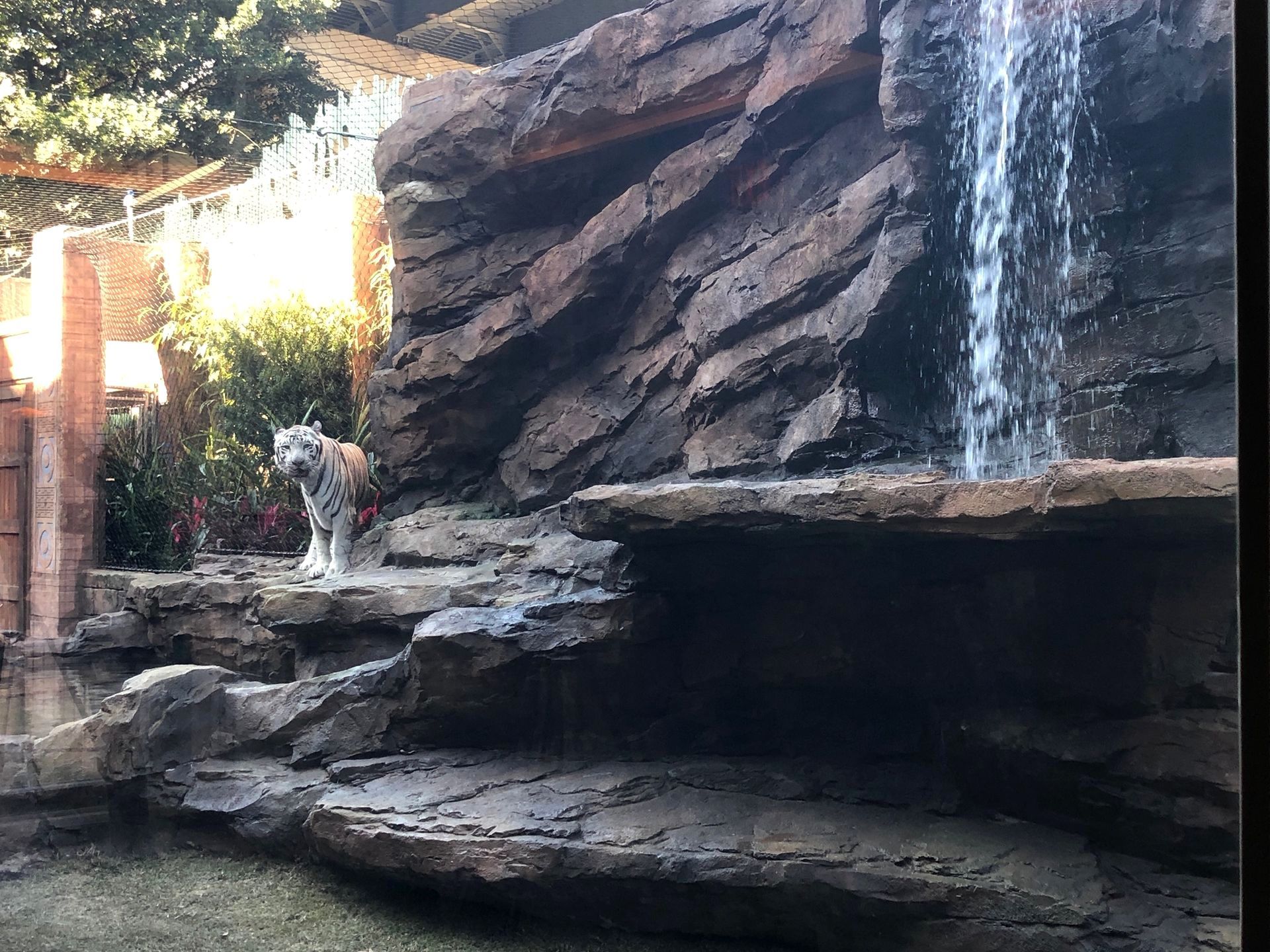
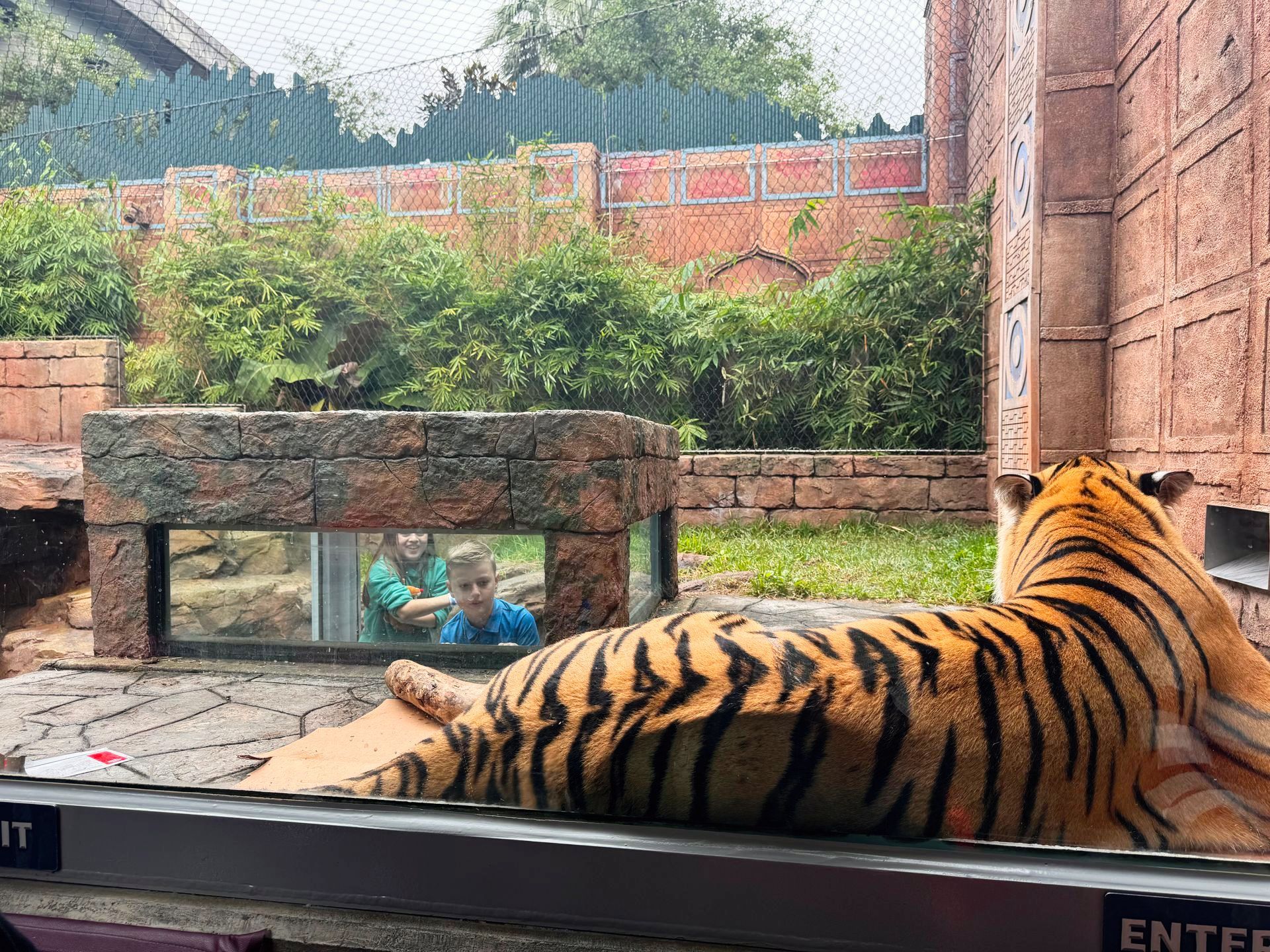
animal enrichment
Animal enrichment provides our animals with stimulating activities and environments to promote physical, mental and emotional well-being. This involves encouraging natural behaviors, stimulating curiosity, and offering choices and control within their surroundings.
For our tigers, enrichment is designed to mimic the challenges they would encounter in the wild, ensuring they remain physically active and mentally sharp.
Apollo loves wrestling with large enrichment items like boomer balls and barrels, especially if they are hung up with a bouncing bungee cord!
Sisters Kirana and Zara enjoy frozen blood pops, a variety of scents, and playing in large mounds of hay!
Sensory Enrichment
Scents and Spices:
We use various scents like cinnamon, pepper, animal scents, and perfumes to stimulate the tigers' sense of smell. These scents are hidden in different areas of their enclosure, encouraging them to explore and investigate.
Sound Enrichment: Natural sounds, such as bird calls or rustling leaves, are played to create an immersive environment. Sometimes, we even play recordings of other animals to pique their curiosity.
Food Enrichment
Puzzle Feeders: These are devices that require the tigers to solve a puzzle to access their food. This not only makes mealtime more engaging but also helps develop their problem-solving skills.
Frozen Treats: On hot days, we provide frozen meat or blood popsicles. These treats are not only refreshing but also encourage the tigers to use their claws and teeth to get to the food.
Physical Enrichment
Climbing Structures: Our enclosures are equipped with platforms, logs, and trees that encourage climbing and jumping. This helps maintain their physical fitness and provides a vantage point for them to survey their territory.
Swimming Pools: Tigers love water and our enclosures have pools where they can swim and cool off. Did you know Sumatran tigers have partially webbed feet?
Cognitive Enrichment
Training Sessions: Our keepers conduct regular training sessions using positive reinforcement. These sessions are not only mentally stimulating but also help in medical check-ups and care.
Novel Objects:
We introduce new objects like balls, barrels, and even cardboard boxes. These items are rotated regularly to keep the tigers interested and engaged.
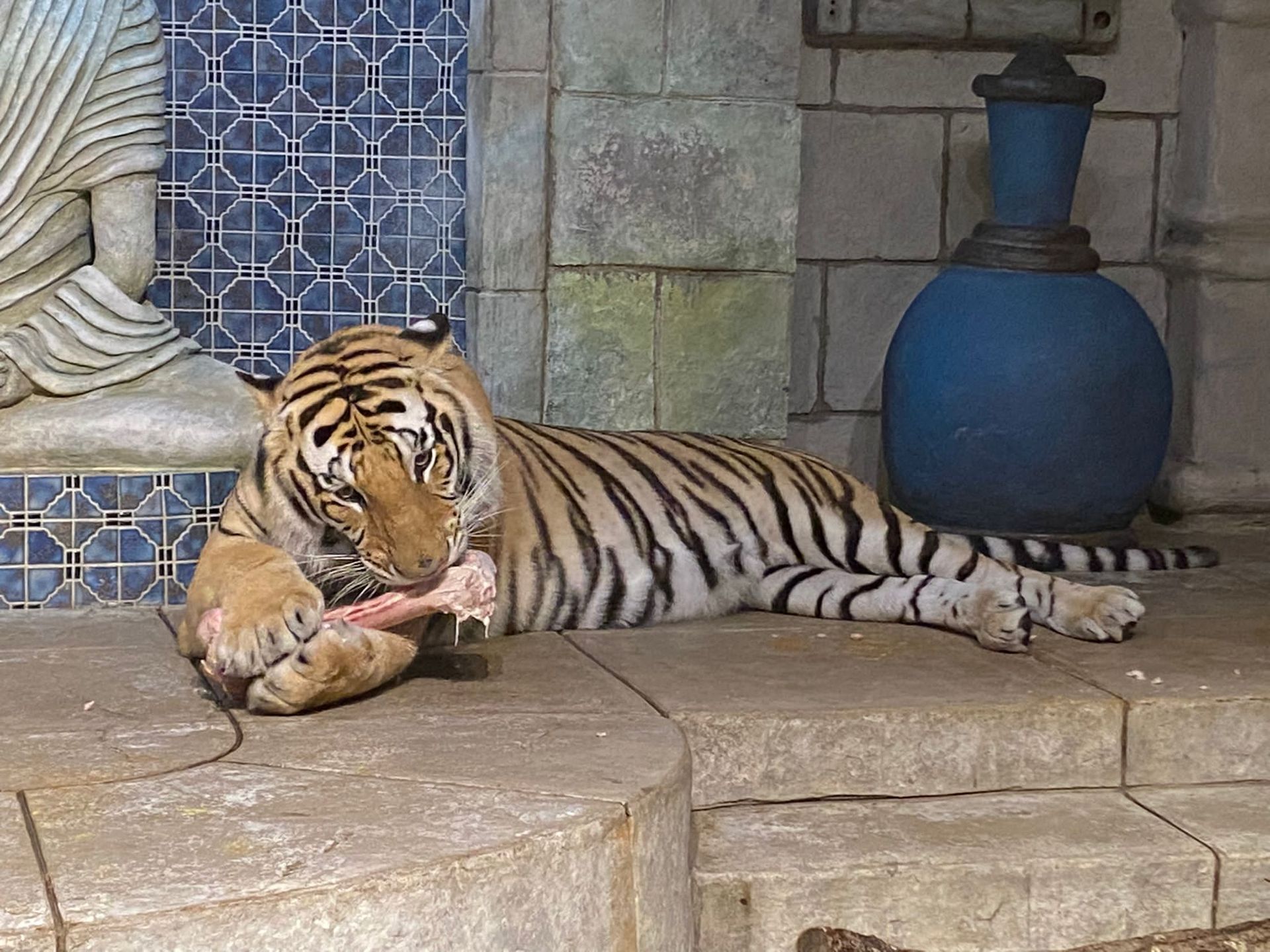
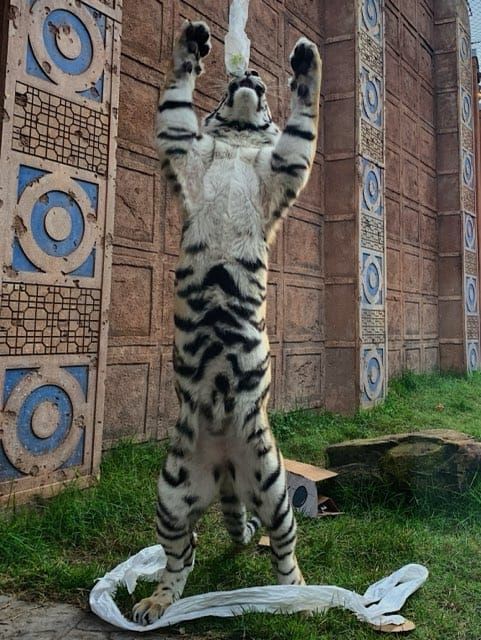
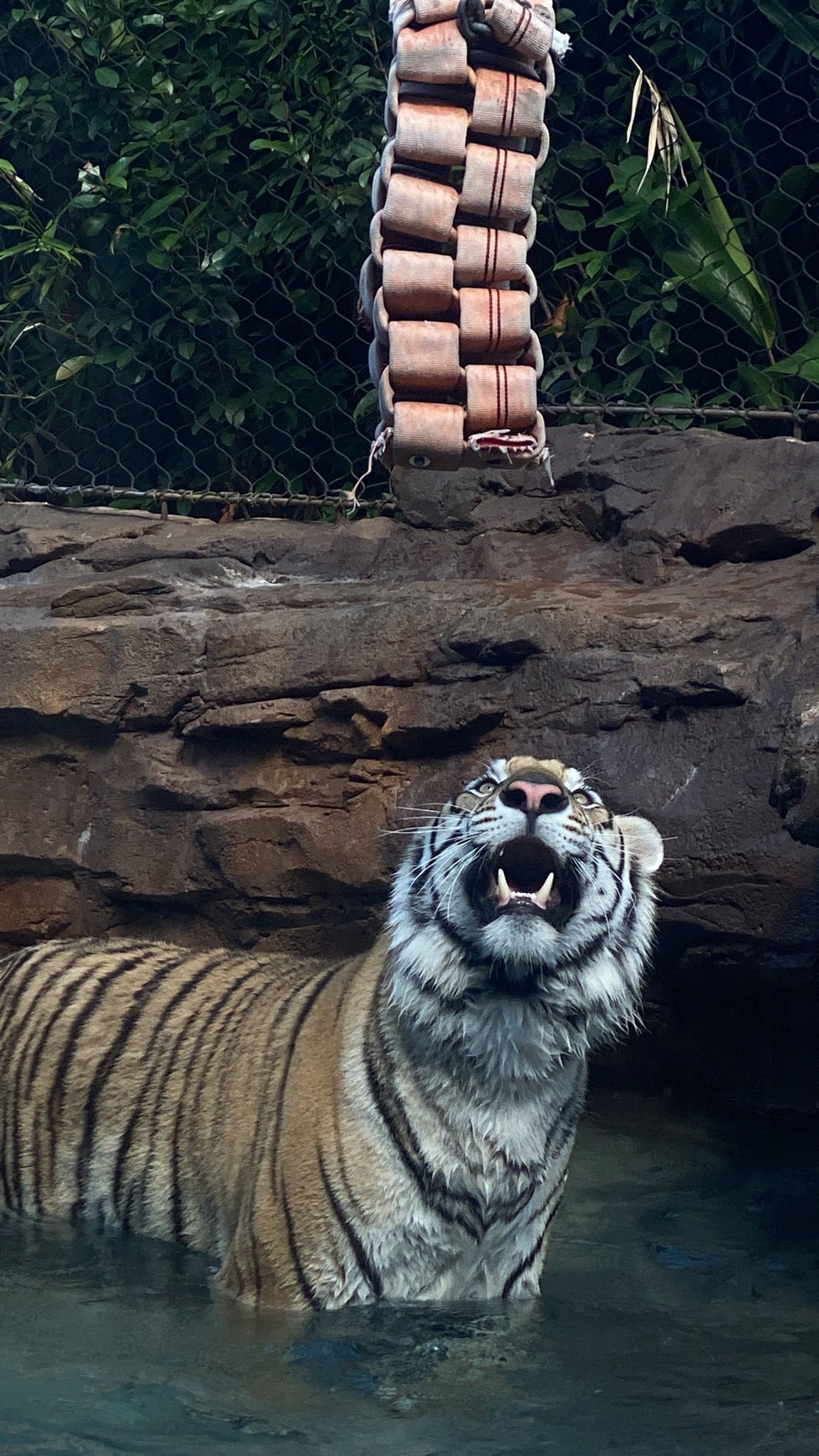
Bengal & Sumatran tigers
What's the difference?
Bengal tigers are one of the biggest subspecies of cats roaming the Earth today.
- Majority of Bengal tigers sport yellow to light orange coats with brown to black stripes, but their bellies and the inward-facing sides of their limbs are white, just like Apollo!
- Bengal tigers have very large, sharp teeth. They fall between 3 and 3.9 inches from the gum line, making them the biggest canine teeth of all cat species.
- Bengal tigers live in India, Bangladesh, Nepal, and Bhutan.
- Only 3500 remain in the wild.
- CONSERVATION STATUS:
CRITICALLY
ENDANGERED
Sumatran Tigers are the smallest of the tiger species!
- Majority of Sumatran tigers have darker orange-tan fur with broad black stripes. Compared to other species, Sumatran tigers have more stripes.
- Sumatran males weigh up to 310 pounds and females weigh around 165 to 243 pounds.
- Because of their smaller statures, Sumatran tigers are more agile than other tiger species.
- Sumatran tigers believe in conserving energy and sleeping 18 to 20 hours a day!
- Sumatran tigers are like the Michael Phelps' of the big cat world. They’re powerful swimmers! They love the water and even have paw webbing.
- Wild Sumatran tigers are native to one place only: Sumatra, one of the Indonesian Sunda Islands.
- Only 250-400 remain in the wild.
- CONSERVATION STATUS:
CRITICALLY ENDANGERED

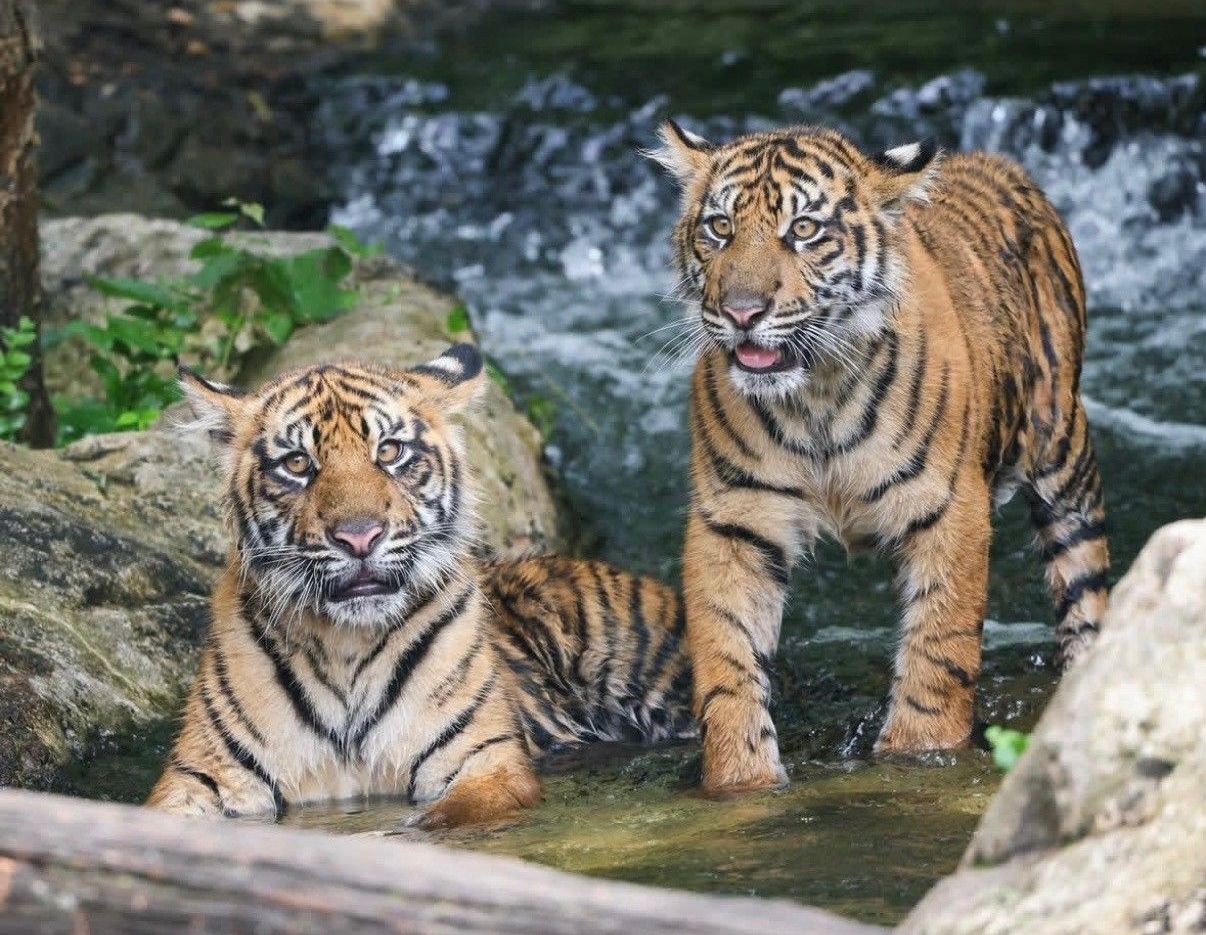
private tiger meet & feed
Join us for an exclusive, up-close encounter with Downtown Aquarium's tigers! In this unique experience, you will learn all about animal training, big cat husbandry, tiger conservation, and have the opportunity to feed a tiger!
During this experience, you will:
- Learn all about these amazing animals and what you can do to help protect their natural habitats
- Meet the knowledgeable animal care experts who care for our tigers
- Observe and participate in a training demonstration
- Feed the tiger some of their favorite food
- Photo opp with tiger
Duration
Your experience will last 25-30 minutes depending on the animal, your group size, and level of participation.
Rate
$120 per person, plus tax for up to 6 participants, including children.
Children under 2 years old are free and not included in the headcount. Children under 2 years old must be held by an adult at all times during the Tiger Meet & Feed.
This rate includes your Private Tiger Meet & Feed and All Day Adventure Passes to the Aquarium Exhibit, Stingray Reef and all amusement rides.
Please Note: Due to the nature of this animal, Guests will not have any direct physical interaction with the tiger. Specific tigers cannot be guaranteed but if you have a special request, please let us know and we will do our best to accommodate. The interactive activities available that day are solely up to the individual animals and whether or not they choose to participate.
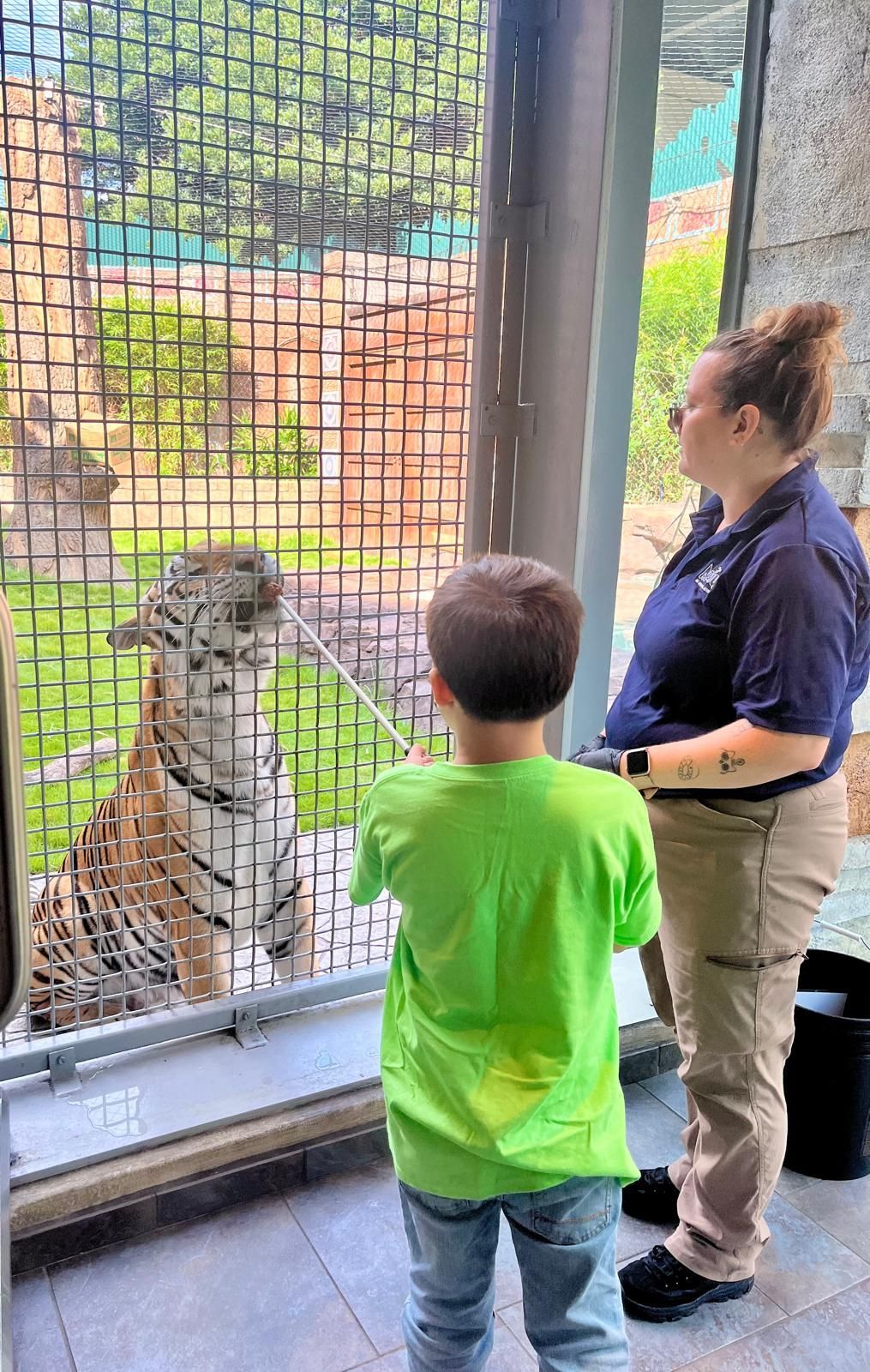
tiger conservation
The Downtown Aquarium partners with Wildlife Alliance, a non-profit organization dedicated to eliminating the illegal wildlife trade. Allowing threatened species to recover to safe levels. Landry's / Downtown Aquarium helped fund the construction of a ranger station, built to help prevent the illegal hunting and breeding of tigers.
SPECIES SURVIVAL PLAN PROGRAM - AZA
Our sister pair of tigers (Kirana & Zara) are welcomed as part of the Species Survival Plan (SSP), a nationwide program focused on the conservation of endangered species through responsible population management.
SSPs are breeding and conservation programs managed cooperatively through the Association of Zoo and Aquariums (AZA) to ensure the long-term survival of many species. Their stay will help prepare them for adulthood and future opportunities to contribute to the species' survival through breeding and continued conservation work.
Honoring Our Four Original Bengal Tigers
At the Downtown Aquarium, our tigers are more than ambassadors for their species, they are cherished members of our family. Each tiger brings a unique personality, unforgettable moments, and a powerful presence that touches the hearts of Guests and staff alike. As we honor our original four Bengal tigers – Coral, Nero, Reef, and Marina – we also celebrate the extraordinary care they received and the conservation mission they helped inspire.
Coral (2004 – 2021)
Spirited and stunning, Coral was known for her playful pounces and deep bond with her companion, Reef. She loved peppermint-scented enrichment and had a special fondness for a very particular red boomer ball. Losing her to cancer was heartbreaking, but her memory lives on in the joy she brought to so many.
Nero (2003 – 2024)
Gentle and wise, Nero was the oldest male in our tiger family. He greeted familiar faces with a friendly chuff and enjoyed bubble baths, boomer balls, and lounging in his hammock. His mellow nature and warm spirit made him a favorite among Guests and staff alike.
Reef (2004 – 2024)
Energetic and social, Reef never lost his youthful spark even in his old age. He was always vocal, often calling out to his fellow tigers and chuffing at his keepers. His green boomer ball and frozen goat milk treats were his favorite enrichment items. Reef’s vibrant personality made him the heart of our tiger habitat.
Marina (2003 – 2025)
Graceful and regal, Marina was the oldest Bengal tiger in the AZA population at the time of her passing, a testament to the exceptional care she received throughout her life. She loved perfume-scented enrichment and shredding paper products. Her quiet strength and dignified presence commanded respect, and though she was reserved, she was unmistakably the matriarch of our tiger family.
Coral, Nero, Reef, and Marina may no longer walk among us, but their legacy lives on in the lives they touched, the awareness they raised, and the future they helped shape. In their honor, we remain committed to global tiger conservation through ongoing donations and partnerships with like-minded organizations. These efforts play a vital role in protecting tiger habitats, reducing human-wildlife conflict, and creating a world where tigers can thrive.
Certifications
Our tiger exhibits were designed and constructed with the recommendations of large carnivore experts from across the country. Our exhibit is accredited by the Association of Zoos & Aquariums (AZA), the United States Department of Agriculture (USDA) and the Zoological Association of America (ZAA), all of which hold the property to the highest of industry standards.
Downtown Aquarium Houston is one of 230 accredited members of the AZA. Fewer than 10 percent of all USDA public display permit holders are able to meet AZA’s rigorous accreditation standards, and Downtown Aquarium Houston has done so since 2004. Routine inspections by USDA are conducted annually and the property remains in total compliance.
Certified by AZA, USDA and ZAA, the Downtown Aquarium Tiger exhibit employs a full-time staff, with over 40 years of zoo and aquarium experience that monitor the cats 365 days a year. In addition to our staff, we also have three veterinarians that visit the facility and provide care to the tigers several times a month and remain on-call 24 hours a day, seven days a week.

